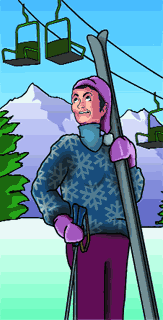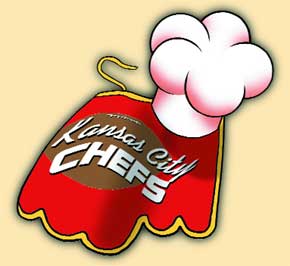
Fall 2001
CONTENTS Leaving Life in the Parking Lot
Where is the Parking Lot?
Fighting the World's Fight
Diva in Her Own Right
AROUND THE OVAL
LETTERS TO THE EDITOR
BOOKS
SPORTS
CLASS NOTES
ALUMNI NOTES
Contact Us
About the Montanan
PAST ISSUES
Where is the Parking Lot? Foreigner in the land of fandom By Megan McNamer Illustrations by Bob Zingmark 
I live close enough to UM’s Washington stadium that if I were to take my car to a Grizzly football game, I’d simply pull out of the driveway and park on the street. If I were to go on foot, it would take fifteen minutes, door to seat. If I were to ride my bike, I could finish listening to the opera on KUFM and be there for the second half. But I don’t drive or walk or bike to Grizzly games at Washington stadium. I don’t go to them at all. I’m not a football fan. Now, hang on. I’m not against football. When I say I’m not a football fan it is not the same as when I say, for example, I’m not a fan of capital punishment. The not in the second case is emphatic. In the first, it’s just a statement of fact. It’s like saying I’m not an opera fan, which — despite the well-rounded scenario above — is also true. Recently, though, my children reached the age of awareness and started noticing their inherited deficiencies. So I’ve been giving some thought to this question of fandom. I think there are two reasons I’m not a fan of football or, for that matter, any other organized sport. One. The football games in Cut Bank, Montana, where I grew up, were played at night in subzero weather and a high wind. Of course, I attended every home game there ever was — I was a Wolf! But all my concentration was focused on body warmth, or its noticeable absence. I yelled myself silly, true, but this was a strategy to keep from freezing. I couldn’t see a thing from those low, wooden bleachers anyway. The cheerleaders — their purple noses coordinating with the school colors (their legs an ominous blue) — and the sidelined players, shivering in a clump like weather-threatened calves, obstructed my view of the field. I was never sure what went on out there. Two. The primary place I witnessed televised sports when I was young was at my friend’s house, that friend with the cranky, neatnik mother, so that to this day I associate televised cheering and sports commentary with the sound of a vacuum cleaner. Sports on TV, for me, is inexplicably tied up with chores, mindless noise, mirthless expressions, monotony. I wish this weren’t so. I wish I were a sports fan. Occasionally I’ll give some spectator sport a go, but my presence inevitably betrays a certain . . . absence. Something is missing. I’m not sure what, but I feel an intrinsic lack. I have pompom envy. Worse, I feel I’ve failed my children. Following a football team, or at least some kind of group activity involving a ball, is like having a little English if your language is something else — it makes you conversant with most of the world. You’re in on the lingua franca of the species, or at least the lingo. You may not know the way to San Jose, or wherever it is they play the Snow Bowl, but you can still talk about it. (It’s the Rose Bowl! In Pasadena!) I could blame my children’s education. They started out in a private, nonprofit, save-the-rainforest kind of school that, ironically, has impacted their own evolution. In noncompetitive, hands-on, multi-age classrooms, team taught, they studied topics such as the ozone layer, acid rain and the warming of the planet. I thought it was fabulous. It was. But it should have been supplemented in the home with other global concerns (the ones that vie with the vacuum cleaner). Now they’re experiencing what I think of as the “ballpark effect,” the social fallout from their atypical schooling. At my older son’s orientation to his new, public school classroom, the teacher paced the rows and demanded to know each child’s favorite team. My son was stymied. Then he tried to claim the team of the child in front of him, a move that brought raised eyebrows. Clearly, he had no idea if he’d adopted a basketball team, a football team, or what. A few years later he wrote a back-to-school essay in which he said he was fond of autumn because that’s when you watch the Super Bowl. Busted! And it’s all my fault. When my other son first joined the wider world, we made weekly trips to Target to buy football cards. This was necessary equipment, it seemed, the “camo” needed to traverse the rough terrain of third grade. His attempt to mask his sports ignorance reminded me of someone trying to disguise illiteracy. When I heard him quietly reciting the names of the teams to himself and out came “Kansas City Chefs,” I knew it was too late for him. I felt a sad foreboding. But I did rather like the image of helmets, cleats, mouth guards and . . . aprons. So, okay, I do feel a certain football ambivalence, especially as the mother of sons. There’s a little sixties-seventies subversive residue in there, for me, anyway, and maybe for some of you. Wasn’t it at a Grizzly football game in the early seventies that we enjoyed lime vodka to excess? Well, why the heck not? The sport was baffling, and my friends and I — fresh-from-the-Hi-Line, could-have-been-Lady-Griz-if-we’d-practiced — suddenly realized that it was inordinately male. In fact, it was all male! It was a boy sport, big time. 
Then neo-feminism came along, and we forgot about it. But I later indulged in a bit of retro-chortling when my children, as toddlers, referred to football players as “cartoons.” This was an honest linguistic mistake. One day my older son pointed to a cartoon in the New Yorker featuring football players. Maybe it was along the same lines as a recent one, which depicts two football players philosophizing: “When you put on the uniform, you surrender a part of yourself.” He asked, “What are those?” “Cartoons,” I replied. Soon after, we were driving over the Madison Street Bridge and he said, “Look! Cartoons!” pointing to the practicing Grizzly football players. I just laughed. I should have set him straight then and there. Because now, I fear my boys will never get it. They are entirely too sanguine about organized sports to thrive in that world. (My husband, by the way, is completely sports-dumb and no help at all.) Our younger son began Little League at age nine, and he was a natural. He ran and threw and I believe did all the things you’re supposed to do. He even knew about innings and so forth, and soon he was pitching. But when, the following year, I mentioned “baseball this spring,” he looked at me with surprise. “I already did that,” he said. Well, maybe it was the participatory aspect he was confused about — isn’t fandom something altogether different? No. I don’t believe it is. I think all sports fans are surrogate players. Or players are surrogate fans. If sports is a world, call fandom a country. In Fandom, sports-Esperanto is spoken. The climate is constant, the ozone’s intact. You live there or you don’t. And, believe me, you really don’t if you not only went up to Snow Bowl (a ski area! near Missoula!) on the day the UM Grizzly football team won the NCAA national championship in l995, but you actually asked the lone guy in the pro shop — Where is everybody? Megan McNamer’s essays have appeared in Salon, Islands, trips, Northern Lights, Child and Sports Illustrated (amazingly enough). She holds a bachelor’s degree in music from UM ’76 and a master’s degree in ethnomusicology from the University of Washington. She lives in Missoula with her husband and two sons, who disavow any association with the above story. 
AROUND THE OVAL | SPORTS | CLASS NOTES | ALUMNI NOTES
|